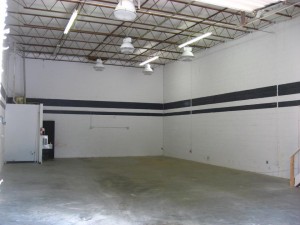I recently got a question about how much space is ideal for a one- to two-man shop.
The ideal size for a shop is one that costs the least and that lets you do the most work in an efficient manner.
When I started out nearly 14 years ago I did so in a 2 car garage, which was barely 400 square feet when it was empty. Since the garage was part of my house it was “free” space; however the tiny space meant I spent a lot of time moving and rearranging equipment to create usable space. This meant it took much longer to do anything, so while the space was cheap it meant I was very inefficient.
Fast forward to my biggest shop: 7000 sq ft. My wet processing area was nearly 800 sq ft in area! I had lots of space to create dedicated areas that were set up for one or two steps: forming and casting, or sealing, or mixing and processing. This made production very efficient because everything needed for those steps was already in place and nothing was in the way. However efficiency came with a price: I needed plenty of floor space to create an efficient setup. And this meant I needed a steady volume of business to pay for that space.
Choosing a shop space is a bit of a chicken and egg kind of dilemma. You need more space to do more work, but you need more work to pay for more space. My advice is to stay small to keep your overhead low and work on being faster and more efficient. This will save you money and those skills translate effortlessly when you do find you need to expand into more space.
To start out in a “real” shop, I think 1500-1800 sq ft is a good starter shop. It’s big enough to have everything you need and let you start creating dedicated areas (though they will either be smaller or will have more overlap with other functions). My first shop (and current R&D facility) is 1800 sq ft (30×60), which is a really nice size. Here is a photo of an 1800 sq ft shop.
You will soon find out what shop sizes are common when you start looking for commercial real estate (to lease). Here in NC 1800 sf is the smallest space that’s available. And that’s because it’s not cost effective for a building owner to subdivide the kind of space we need into smaller units. Plus many different kinds of businesses need a certain minimum amount of space to be viable.
Aside from labor, your shop is your biggest overhead expense. And you still pay for your shop whether you’re working or not. So it pays to find the lowest total cost place that lets you do what you need to do.

